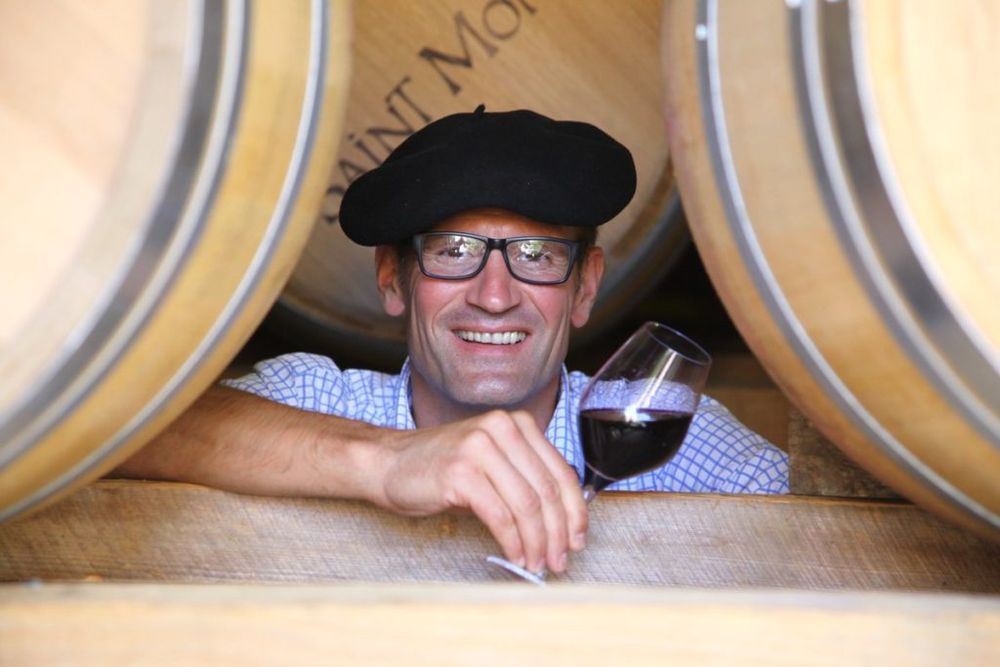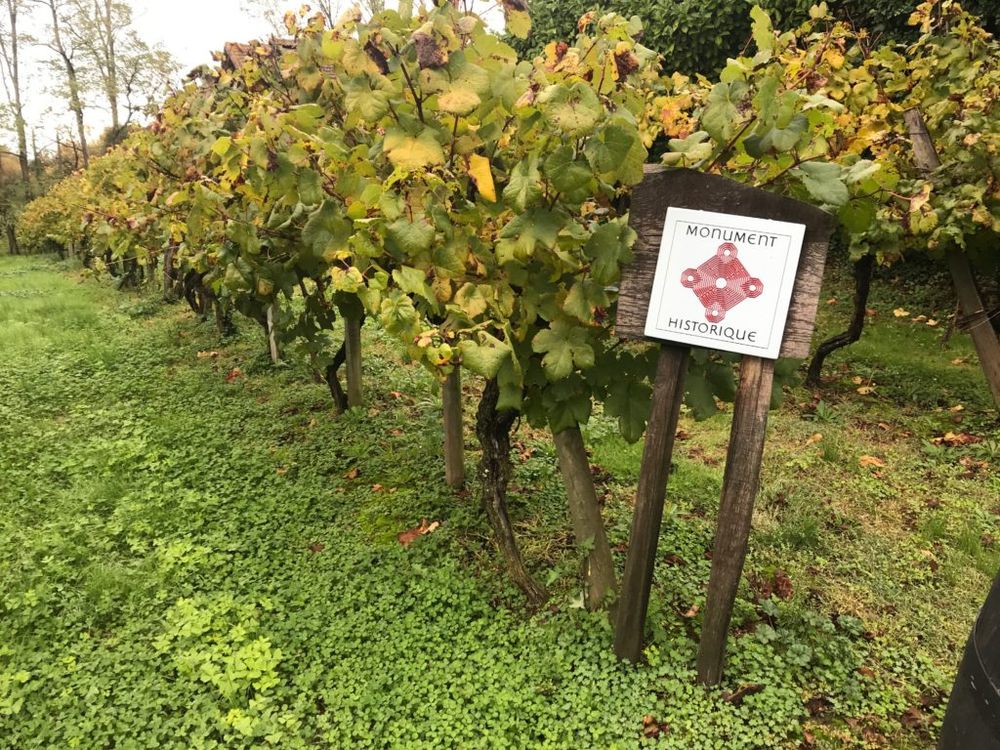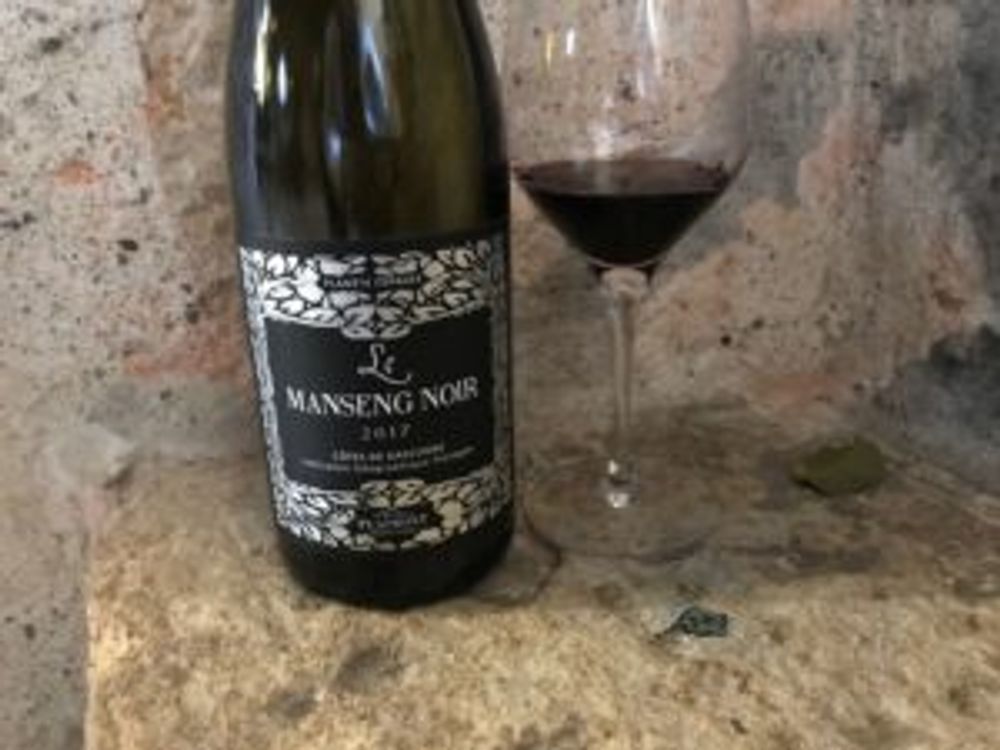So, from discovering Manseng Noir in 2000, reviving it and planting it commercially, Plaimont had its first vintage in 2015. Today the company has 40 hectares and counting.
Adapting wine production to climate change takes many forms, from investing in more sustainable forms of agriculture through to developing vines that can withstand less water and more heat. Wine estates are moving vines to higher altitude and to areas traditionally seen as too cold.
In France’s South West the Bordelais of all people have given permission for the first time for seven grape varieties to be used in the region, the news announced while temperatures reached 60 degrees celcius on the vines in the Languedoc.

The new 5 year old parcel of reintroduced Manseng Noir at Château de Cassaigne, November 2018
For Olivier Bourdet-Pees, director general of Gascogny-based cooperative Plaimont Producteurs, the process of adapting to climate change started almost 20 years ago, and is just starting to bear fruit. His company, which has been innovative and forward-thinking across many areas of ampelography, has looked to an almost extinct grape Manseng Noir to start replacing one of its key grape varieties Tannat.
One of the key drivers here has been the ever-increasing strength of Tannat both in terms of its tannic profile and its ever spiralling alcohol content.
“In 2018 we really struggled to vinify Tannat at anything less than 16% alcohol,” Bourdet-Pees tells me, “In 20 years Tannat it will not be there – we have to prepare.”

“Tannat was just getting too tiring to drink”: Olivier Bourdet-Pees, director general Plaimont Producteurs
Bourdet-Pees explains that this staple red of the South-West was simply becoming ‘too big’.
“It was just getting tiring to drink,” he continues, “so in 2002 we stopped extracting it, we were the first ones round here to decide to make a different style of Tannat.”
Plaimont is looking to a grape variety related to Tannat, Manseng Noir, as a long-term replacement because it can achieve much lower levels of alcohol – as little as 11%. Ironically it was this ‘weakness’ that saw it start to go out of fashion in a time when growers were paid more for higher levels of alcohol.
Phylloxera then struck and it slowly disappeared until, that is, a 200 year-old vineyard was discovered in Viella AOC Madiran, that contains 41 grape varieties – many unknown – all pre-phylloxera and including the last known remaining vine of Manseng Noir.

When the 200 year-old pre-phylloxera vineyard was disovered it contained the last known remaining vine of Manseng Noir
You can read more about this vineyard here – in a nutshell it is a privately-owned vineyard whose sandy soil was deep enough to prevent phylloxera destroying the vines. The vineyard is an Aladdin’s cave for the ampelographer and the only non bricks-and-mortar site to be granted an Historical Monument status in France, although you won’t find any signs to it – nobody wants tourists here to avoid contaminating it.
Plaimont has its own ampelographic conservatory in which ancient varieties including Manseng Noir are being revived. Another variety that is leading to full scale production is Tardif.
So, from discovering Manseng Noir in 2000, reviving it and planting it commercially, Plaimont had its first vintage in 2015. Today the company has 40 hectares and counting.

Clément Dubos with a bottle of single variety Manseng Noir, Château de Cassaigne
The vigneron entrusted with this valuable project is Clément Dubos, who has his own vineyards but oversees production at Plaimont’s Château de Cassaigne where the five-year old Manseng Noir vines are planted.
“In the first year we had to lots of green harvest, it was producing 90 hectolitres per hectare, and yet the quality was consistently good. In the second year it hardly produces – around 40 hectolitres – and now it has settled to around 80 hectolitres,” says Dubos.

The wine is used as a (30%) blending partner to Merlot in the new cuvée Moonseng (“we didn’t have enough so we had to blend”) and has just started being released as a single varietal, albeit in limited quantities (6,000 bottles total) – the fruit taken from better soil/ lower-yielding plants with greater selection.
Dubos explains that, as a cousin of Tannat, Manseng Noir has the same deep colour “But it has not got the same muscularity, it also has very different rotundones – it brings spiciness and lower alcohol.”

Tasting the 2017 Le Manseng Noir (ABV 11.4%) the nose is very spicy, inky with a wild herb (thyme) element; the palate is fresh, and surprisingly complex with fine silky tannins, fine texture ending on a dry stone, slightly citrus finish.
What is also good to see is the pride in the back label that reads “A lost, forgotten grape variety from the Pyrenean foothills. End of story?…NO! Plaimont has revived the grape to create Gascogny’s fine red wines of tomorrow.”

The pride goes all the way to the cork – “rediscovered by Plaimont”
The theme is echoed by Bourdet-Pees “When we created our own ampelographic conservatory in 2002, this ‘living library’ safeguards the character of our wines and the future of our appellations. Tomorrow, some of the unknown grape varieties of our conservatory will undoubtedly be the hallmark of our ‘original’ great wines.”
If 2017 Manseng Noir is anything to go by, Plaimont is completely on the right track.









































